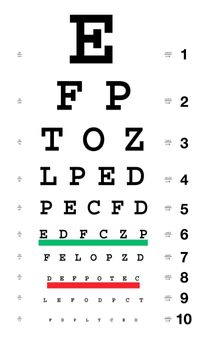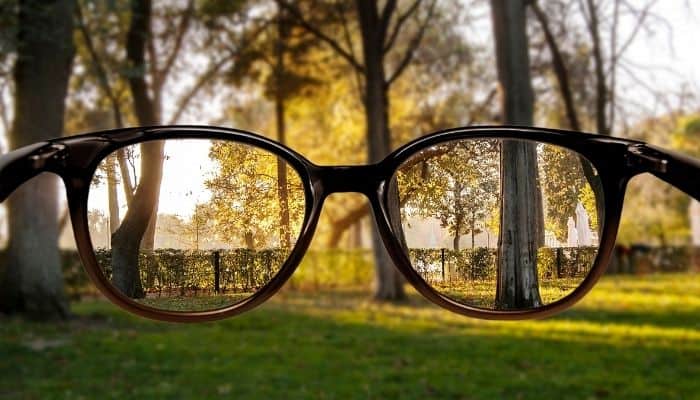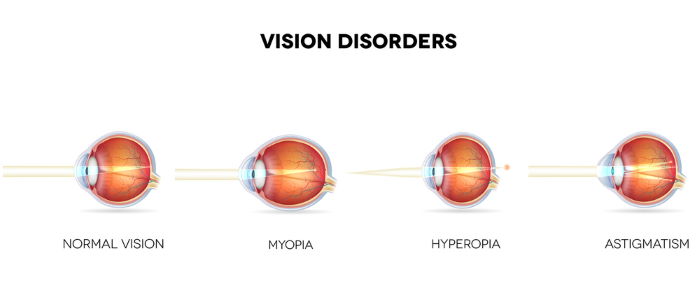
Like most people, I always thought 20/20 vision meant perfect vision. It was a bragging point for me. I told everyone that would listen that I had “eagle eyes.” Best of the best.
Then it happened. I went to the eye doctor and I needed a prescription. After talking to my eye doctor, I realized that I was now part of the 75% of the population requiring vision correction.
So What Does 20/20 Mean?
The American Optometric Association defines 20/20 vision as “a term used to express normal visual acuity (the clarity or sharpness of vision) measured at a distance of 20 feet.”
Even though 20/20 vision is just a benchmark for normal vision, if your vision is worse than 20/20, your doctor aims to have you see at least 20/20 vision with a prescription correction.
If your doctor finds that your vision can not be corrected better than 20/200 even while wearing your glasses, you are considered by most governments to be “legally blind“.
You can also have above-average distance vision. This number would be referred to as 20/15 or better. People with 20/15 vision can see objects at 20 feet that others can only see while standing 15 feet away.
How Do You Test For 20/20 Vision?

You are positioned 20 feet away from the eye chart when you have an eye exam, usually in a doctor’s chair. The chart you’re instructed to look at is referred to as the “Snellen Eye” Chart.
It was developed in 1862 by a Dutch eye doctor named Herman Snellen and is still used today.
On this vision chart, the lowest or worst vision, the big letter E, is 20/200, which means that you need letters ten times as big as the letters on the 20/20 line to see the image clearly.
People often think that 20/20 vision means they have perfect eyes. This can be dangerous because there are many aspects to eye health.
For example, peripheral vision, color vision, eye pressure, eye coordination, focusing ability, depth perception, and many other components of your eyes contribute to your overall visual ability.
The level known as legally blind means your “best-corrected visual acuity is 20/200,” meaning a person with 20/200 vision can read at 20 feet away what a person with normal vision can see from 200 feet away.
Why Don’t I Have 20/20 Vision?
Most of us have some form of refractive error that prevents us from having 20/20 vision.
Refractive errors like nearsightedness (myopia), farsightedness (hyperopia), and astigmatism are the main reasons we can not achieve 20/20 vision without our glasses.
If you have myopia, the images you see don’t focus on your retina but in front of it. Nearby vision is clear but distant images are blurry.

On the other hand, when you have hyperopia, the images you see don’t focus on your retina but behind it. Distant images are clear, but you see nearby images blurry.
Astigmatism, also called cylinder, occurs when the shape of your cornea, the surface layer of your eye, is not perfectly spherical. When you have astigmatism, light that enters your eye focuses at different points on your retina.

Genetics can also play a part in your visual acuity. According to J.P. Lowery, O.D., “Nearsightedness and farsightedness have a strong genetic component, especially if a parent is very nearsighted or farsighted. If both parents are nearsighted or farsighted, there’s a good chance their child will be the same.”
Additionally, environmental factors such as close reading also affect the development of myopia, especially in students who spend a lot of time reading.
As we get older, the development of cataracts can cause our eyesight to deteriorate. Cataracts are when the natural lens in your eye becomes cloudy and causes symptoms like blurry vision, sensitivity to glare, and diminished night vision.

Once your vision can no longer be corrected to 20/20 with glasses, cataract surgery is recommended. There are more than 2 million cataract surgeries performed in the United States each year.
There are hundreds of other reasons your vision can be less than 20/20, ranging from seasonal allergies to serious vision problems such as retinal detachment or severe eye infections.
Comprehensive eyecare includes regular eye exams to evaluate the health of your eyes. The key to maintaining good vision for a lifetime starts with the early detection and treatment of vision problems.
Cynthia is a published author and freelance writer that has enjoyed a career in the eyewear industry for more than 25 years. In 2016, she decided to combine her passion for writing with her experience as an Optician and launch her company, Pizzini Writes. She now dedicates her days to writing about the latest optical-related news and trends for various publications and independent retailers.
Learn more about her at www.pizziniwrites.com